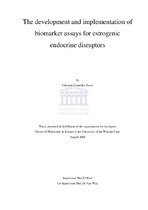The development and implementation of biomarker assays for estrogenic endocrine disruptors
Abstract
Endocrine disrupting chemicals (EDCs) are compounds found in the environment that have the potential to disrupt normal endocrine function. Estrogenic EDCs (e-EDCs) is a subclass of EDCs and is defined as substances contaminating the environment that may mimic or inhibit the effect of endogenous estrogen and therefore may influence developmental and reproductive health in humans and animals. The aim of this study was to develop, validate and implement a battery of in vitro and in vivo screening assays for e-EDCs. The study was concluded by implementing this battery of assays to assess the Eerste River, South Africa at three sampling sites, namely Jonkershoek, Stellenbosch sewage treatment works (STW) effluent and Spier for e-EDCs. The control site, Jonkershoek contained very low levels of estrone. Water from this site showed no estrogenic activity when the E-screen and the ER_ induction in MCF-7 cells. Some of the water samples collected at this site tested positive for estrogenicity when analysed with the juvenile tilapia VTG assay, whereas the rest were negative. The estrone levels in the sewage effluent extracts as well as Spier were significantly higher. The assay using ER_ protein induction by the MCF-7 cell line, the MCF-7 proliferation assay and the tilapia in vivo screen for estrogenicity showed that these samples are estrogenic. Results obtained for estrogenicity at the three different sampling sites for each of the assays in the battery were comparable. In this study we developed, validated and also implemented a battery of assays encompassing both in vitro and in vivo assays, based on different biological mechanisms, to detect estrogenic EDCs. To our knowledge, this is the first study that has used a battery of bioassays to specifically assess a South Africa river for estrogenicity.

